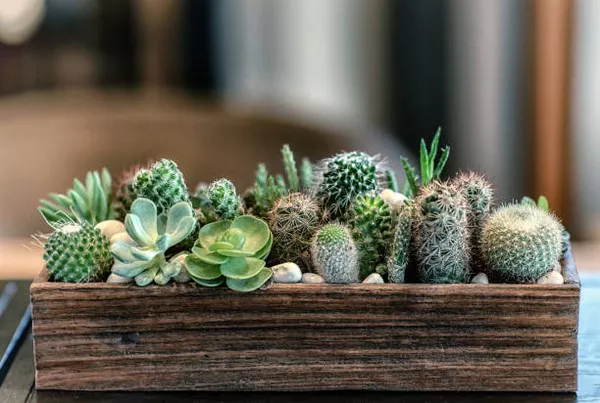In recent years, succulents have become the darlings of the gardening world, capturing the hearts of enthusiasts with their unique beauty and low-maintenance charm. One innovative way to showcase these resilient plants is by creating a vertical succulent garden. Vertical gardens not only maximize limited space but also provide an eye-catching display that adds a touch of nature to any environment. This comprehensive guide will walk you through the step-by-step process of creating a stunning vertical succulent garden, highlighting the unique characteristics of succulents that make them ideal for such a project.
Understanding Succulents
Before delving into the intricacies of planting a vertical succulent garden, it’s crucial to understand the key features that make succulents stand out. Succulents are a diverse group of plants known for their ability to store water in their leaves, stems, and roots. This adaptation allows them to thrive in arid conditions and makes them resilient to drought. The word “succulents” encompasses a wide variety of plant species, including but not limited to cacti, aloe, sedum, and echeveria. The versatility of succulents makes them suitable for various gardening projects, including vertical gardens.
Choosing the Right Succulents
The success of your vertical succulent garden hinges on selecting the right succulent species. Each succulent has its unique growth habits, water requirements, and sunlight preferences. When choosing succulents for your vertical garden, consider factors such as color, texture, and size to create an aesthetically pleasing composition. Opt for a mix of trailing, rosette-forming, and upright succulents to add depth and visual interest to your vertical garden. Keep in mind that succulents with similar care requirements will thrive together, ensuring a harmonious and healthy garden.
Planning and Designing Your Vertical Garden
A well-thought-out plan is the foundation of any successful gardening project, and a vertical succulent garden is no exception. Begin by assessing the available space and determining the orientation of your garden to ensure that your succulents receive adequate sunlight. Consider the overall design of your vertical garden, taking into account factors such as color scheme, texture, and the arrangement of different succulent varieties. Sketching a rough design can help you visualize the final result and make necessary adjustments before planting.
Preparing the Vertical Garden Structure
The structure of your vertical garden plays a crucial role in the success of your project. Choose a suitable vertical garden system based on your preferences and available space. Options range from vertical planters and hanging wall pockets to DIY pallet gardens. Ensure that the chosen structure provides proper drainage to prevent waterlogging, a common issue that can harm succulents. To accentuate the keyword “succulents,” consider incorporating unique containers or planters that showcase the individuality of each plant.
See Also: How to treat mealybugs on succulents?
Soil Preparation for Succulents
Succulents thrive in well-draining soil, making soil preparation a critical step in your vertical garden project. Create a succulent-friendly soil mix by combining potting soil with perlite or sand to improve drainage. The goal is to prevent water retention in the soil, as succulents are susceptible to root rot when exposed to excessive moisture. As you prepare the soil, keep in mind that succulents prefer slightly acidic to neutral pH levels. A well-balanced soil mix provides a nutrient-rich environment for your succulents to flourish.
Planting Your Vertical Succulent Garden
With the groundwork laid, it’s time to start planting your succulents. Begin by arranging the selected succulents in the desired pattern, considering factors such as color contrast and growth habits. When planting, leave enough space between each succulent to allow for proper airflow and prevent overcrowding. Gently remove each succulent from its container, being mindful of the roots, and plant it in the prepared soil. Water the newly planted succulents sparingly, allowing the soil to settle and the roots to establish themselves.
Caring for Your Vertical Succulent Garden
Succulents are renowned for their ability to thrive with minimal care, but they still require attention to ensure optimal growth. Watering is a crucial aspect of succulent care, and it’s essential to strike the right balance. Allow the soil to dry out between waterings, and be cautious not to overwater, as this can lead to root rot. Fertilize your vertical succulent garden sparingly, using a balanced, water-soluble fertilizer diluted to half strength during the growing season. Regularly inspect your succulents for signs of pests or diseases, addressing any issues promptly to maintain a healthy garden.
Maintaining the Aesthetic Appeal
To maintain the aesthetic appeal of your vertical succulent garden, regular maintenance is key. Prune and remove dead or damaged leaves to encourage new growth and maintain the overall health of the plants. Keep an eye on the size of your succulents, as some may require occasional trimming to prevent them from overpowering their neighbors. Additionally, rotate your succulents periodically to ensure even exposure to sunlight and prevent them from leaning or stretching towards the light source.
Conclusion
Creating a vertical succulent garden is a rewarding and visually striking way to showcase the beauty of these unique plants. By understanding the distinctive features of succulents, choosing the right varieties, and carefully planning and maintaining your vertical garden, you can create a stunning display that highlights the keyword “succulents” in every aspect. Whether you’re a seasoned gardener or a beginner, embarking on the journey of planting a vertical succulent garden is sure to bring joy and a touch of nature to your living space.


